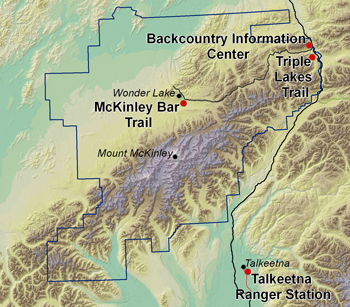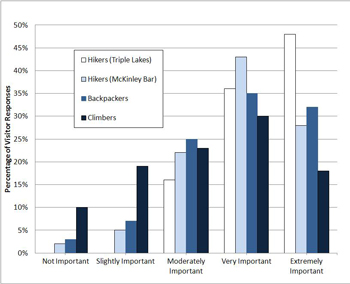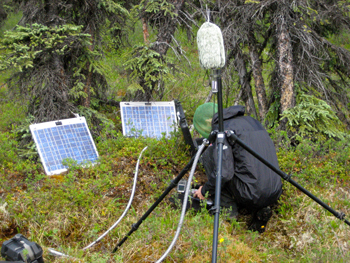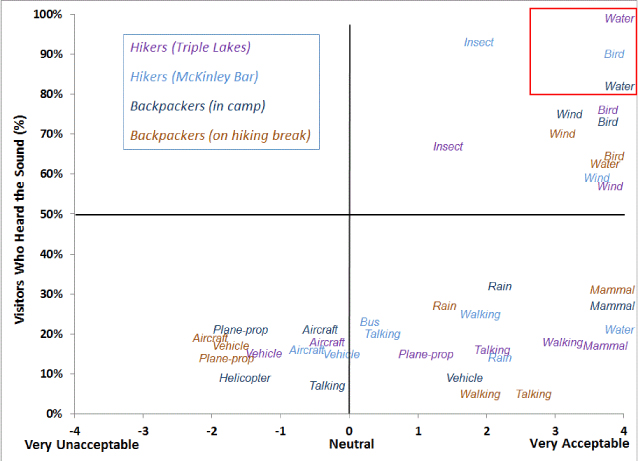The visitors stood quietly and listened. It was a sunny, summer day in Denali National Park and Preserve, and they were in the backcountry about a half mile down the Triple Lakes Trail. She heard the nearby river, a bird singing, a mosquito, some kind of plane, and the chatter of a group of people approaching. She marked off those sounds in the survey booklet a researcher stationed nearby had given her. In the course of about 10 minutes, they completed the questions and returned the booklets to the researcher who thanked them for their voluntary participation.
Why Survey Visitors About Sounds in Denali?
Just as the protection of “landscapes” is a key component of the National Park Service (NPS) mission, the protection of “soundscapes” and quiet has become an integral part of protecting park resources and experiences for visitors. Quiet and the sounds of nature are some of the most important reasons visitors give for spending time in national parks, yet human-caused noises (vehicles, aircraft) continue to increase.
NPS policies direct park managers to protect natural soundscapes from unacceptable impacts and restore natural conditions where park soundscapes have become degraded. Denali’s backcountry plan— an amendment to the park’s general management plan— includes the disturbance of natural sound among the important aspects of a visitor’s experience that need to be managed.
The survey is part of an effort to articulate desired soundscape conditions in Denali and to identify possible indicators for the quality of a visitor’s experience related to natural sounds. Specifically the survey was designed to answer the following questions: (1) How important are sounds of nature to the reasons for visiting Denali? Does the importance of those reasons differ by group (i.e., those that hike close to the park entrance, those that hike in a more remote location, and climbers on Mount McKinley)? (2) What sounds are visitors hearing at different locations? How do visitors evaluate these sounds (i.e., as pleasing or irritating, and as acceptable or unacceptable for a park setting)? (3) What sounds would be good indicators of a quality experience of natural sound?

Conducting the Survey
During summer 2011, Denali’s social scientist and researchers from Colorado State University (graduate student Derrick Taff and Dr. Adam Gibson under the guidance of Dr. Peter Newman) surveyed hikers along the Triple Lakes and McKinley Bar Trails; backpackers at the Backcountry Information Center; and climbers at the Talkeetna Ranger Station for a total of 672 surveys.
The researchers asked all visitor groups to choose their primary reasons for visiting Denali. On trails and in the backcountry, hikers answered questions related to what sounds they heard during the listening activity.

Results: Importance of Soundscapes to Visitors
Of the eight reasons for visiting Denali that were listed in the survey, the two related to soundscapes were Experiencing the sounds of nature and Enjoy peace and quiet. In general, the two reasons related to natural sound were very important to most Denali visitors (see graph at right). Respondents who placed the highest relative value on both of these reasons were the hikers on the Triple Lakes Trail. In contrast, climbers rated these reasons lower, and instead gave the highest relative value to A sense of challenge, Exercise, and Appreciating scenic beauty. On average, all respondents valued Experiencing a sense of connection with nature more than either Enjoy peace and quiet or Experiencing the sounds of nature.
Results: Sounds Heard
The sounds heard by visitors were plotted by frequency (percentage of visitors who heard the sound) and by how acceptable the sounds were to visitors (see graph below). For example, common sounds heard by more than 50 percent of visitors along the Triple Lakes Trail were wind (60%), insects (70%), bird song (75%), and running water (nearly 100%). No surprise—sounds of insects and rain were less pleasing sounds than birds and running water.
For the most part, human-caused sounds were rated less than acceptable for a park setting. When helicopters, planes (propeller), and unknown aircraft were heard, the sounds were rated lower on the acceptability scale than vehicles (e.g., bus on the park road or George Parks Highway). Vehicles were considered slightly annoying to visitors. Most human-caused sounds were intermittent so less than 25 percent of visitors heard them.
Results: Sounds Useful as Indicators
Identifying the sounds that occur more frequently and are highly acceptable (those sounds in the upper right in the red box on the graph below left) helps the park understand the soundscape experience for a visitor. Very acceptable natural sounds, which were heard by more than 75 percent of the visitors surveyed, were running water and birds. These sound conditions contribute to a positive visitor experience.

NPS Photo
What’s Next?
During the survey, park staff made continuous sound recordings at each survey locations (see photo at right). For the next phase of the study, the researchers will use these sound recordings to develop a series of sound clips that combine potential indicators of a desireable park soundscape (i.e., natural sounds such as bird songs and running water) with human-caused sounds that may detract from the visitor experience of natural sounds (i.e., aircraft and other vehiclegenerated noises). The clips will be manipulated so that the natural sounds are mixed with various frequencies, durations, and amplitudes of the unacceptable sounds. Visitors will listen to these sound mixes and evaluate if and when the natural sounds become unacceptably impacted.
The researchers will provide park managers with information related to the acoustic environment as heard by visitors (e.g., the maximum loudness that is acceptable from human-caused sound sources, or the noise-free interval that is optimal for visitors). These indicators can be used to monitor and protect Denali’s natural soundscapes so visitors have the opportunity to experience natural sounds and quiet.

Last updated: August 31, 2016
